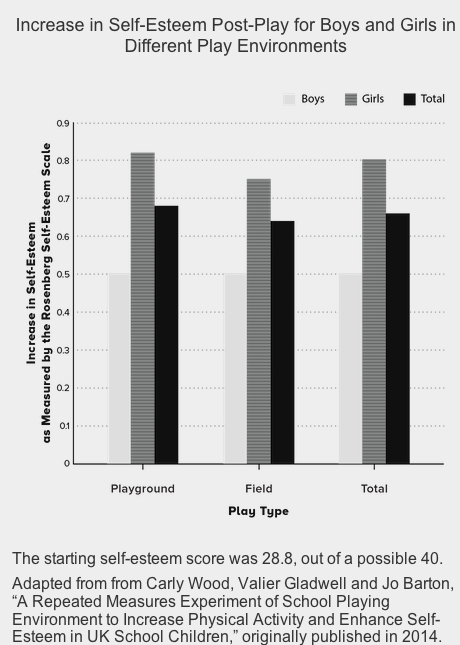Questions 1-11 are based on the following
passage.
This passage is excerpted from Carly Wood, Valier Gladwell and Jo Barton, “A Repeated Measures Experiment of School Playing Environment to Increase Physical Activity and Enhance Self-Esteem in UK School Children.” © 2014 by Wood et al.
The health benefits of engaging in physical activity (PA)
during childhood include enhanced fitness, cognitive function
and bone health; reduced body fatness, motor skill
development, and favourable cardiovascular and metabolic
5 disease risk profiles. Being active during childhood can also
improve self-esteem and reduce symptoms of anxiety and
depression. Participation in PA in youth is of great
importance as PA may track into adulthood where adequate
levels of PA are protective against many chronic diseases.
10 However, in the UK approximately 75% of boys and 80% of
girls aged 5–10 years are not meeting the daily
recommendation of 60 minutes of moderate to vigorous
physical activity . . .
Unstructured play is also an essential part of childhood
15 which enables children to develop a relationship with their
surrounding environment and enhances social skills,
coordination and strength. Outdoor environments facilitate
play and are associated with increased levels of PA. Thus,
children should be provided with daily opportunities to play
20 outdoors. The school environment provides such an
opportunity through the provision of playtime. Playtime
normally takes place on the concrete school playground and
lasts for at least one hour per day. However, universally
playtime is reported to make relatively small contributions to
25 children's overall daily activity requirements. In the UK, only
one known study has reported the contribution of playtime to
overall activity requirements, with contributions being as low
as 4.5%.
A number of studies have successfully increased playtime
30 PA through the introduction of interventions such as sports or
games equipment, playground markings, fitness breaks and
playground structures. However, these types of interventions
tend to facilitate structured rather than unstructured PA.
Unstructured PA is essential to childhood development and
35 therefore needs to be encouraged during playtime.
Natural environments can encourage unstructured play and
may therefore play a role in facilitating unstructured PA
during playtime. Natural environments provide large open
spaces which encourage individuals to be active, whilst areas
40 lacking nature may restrict PA due to limited space and
parental fears over crime and road traffic. Children report a
preference for play in natural environments, with nature
facilitating more imaginative and inventive play.
Furthermore, adolescents living in urban settings with access
45 to green spaces such as parks are more likely to be physically
active than their peers without park access, indicating that all
forms of nature can be used as a tool for engaging youth in
PA. Thus, if school playtime were performed on the school
field it is possible that children's PA levels would be
50 increased. To date, there is a lack of data quantifying the
impact of natural environments on levels of PA in children,
particularly within the school setting.
Performing PA in a natural environment (“Green
Exercise”) has also been demonstrated to provide
55 improvements in self-esteem in adults, whether participants
are simply viewing scenes of nature or directly interacting
with natural environments. Studies in adolescents and
children suggest that Green Exercise has no such additive
effect on self-esteem compared to exercise in other
60 environments. However, the only known study in children
examined the impact of a green playtime intervention
consisting of orienteering.* The task-oriented, structured
nature of orienteering may not facilitate the green exercise
effect. Unstructured free play in a natural environment may
65 allow greater interaction with the environment, thus
benefiting self-esteem.
*A competitive sport in which runners have to find their way across rough country with the aid of a map and compass.